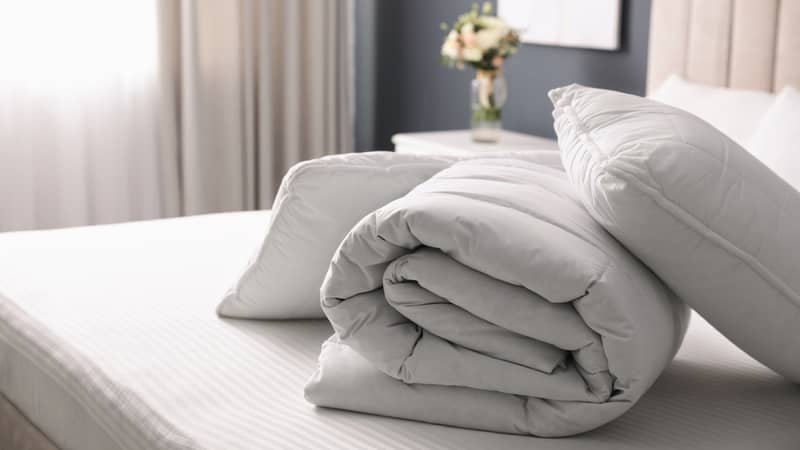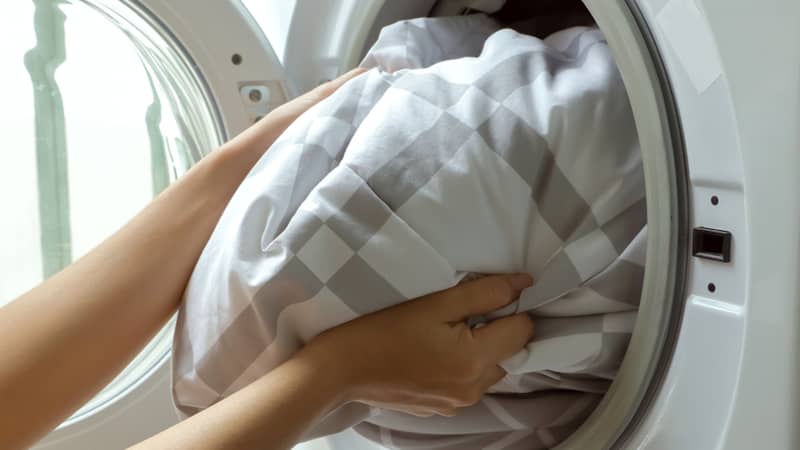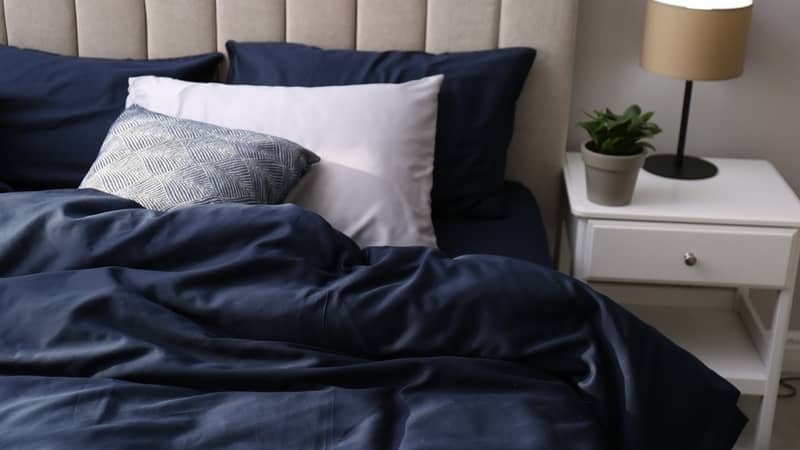There’s nothing like a good night’s sleep while snuggled up in your doona (especially in winter).
But before you toss that fluffy goodness over your sheets, you might want to wash it first.
Can you wash a doona at home? Absolutely! Check the label if you can put it in a washing machine; if yes, use a gentle cycle and cool to warm water. Otherwise, you can wash your doona in the bath with a little elbow grease. Line dry the bedding after it’s been washed and then put a clean doona cover back on.
Don’t let yourself get up close and personal with a dirty doona for 8 hours a day. Learn how to wash a doona – by machine or by hand – then be ready to get cosy!
What is a Doona?
Quilts, doonas, duvets – they’re all the same thing!
These are inserts (usually filled with cotton, wool, or feathers) placed inside a flat cloth cover. They act as thick, warm blankets and go on top of your bed linens.
Doonas are different from weighted blankets. Those are blankets divided into tiny pockets, which are filled with micro glass beads, poly pellets, steel shot beads, or tiny pebbles.
Store your doonas in a dry place such as a linen closet to prolong their lifespan.
Take care of your doona and other linens by keeping your bedroom clean (psst – an experienced home cleaner will do great at that).
How Often to Wash a Doona

At a minimum, you should give your doona a thorough wash every 6 months. As with all other bedding, doonas collect dust mites, oils, dead skin cells, and other dirt.
If you have allergies or want to be particularly clean, wash your doona every 3–4 months.
For the doona covers, wash them every 1–2 weeks.
Before Washing a Doona
Always check your doona’s care label before washing it to see if it has specific care instructions. Some are dry-clean only, which means you shouldn’t risk washing them at home.
There are different washing instructions for different materials – you can’t wash microfibre doonas the same way you can feather doonas. The same goes for doona covers.
The size will also determine how you wash your doona. Smaller sizes can fit in household washing machines (5.0–7.0kg), but larger sizes (over 8.0kg) need larger drums.
As a general rule, if you’re cleaning a doona in a washing machine, there should be enough room for the bedding, detergent, and water to move around comfortably.
Avoid using fabric softener on doonas. They’re generally not that effective, and often leave a residue that will attract more dust and dirt.
If you want to soften your doona while it’s in the laundry, add a cup or two of white vinegar to the rinse cycle. Tea tree oil and lavender oil are optional, but they’ll disinfect your bedding and make it smell nice.
How to Machine Wash a Doona

It doesn’t matter if you use a front load or top load washing machine – so long as the doona fits in the drum.
Take care not to overload your washer, or you could damage both the doona and the machine.
Load the doona into the washer. As an extra step, you can toss in two tennis balls to prevent the fill material from bunching up while it’s tumbling around.
Add your chosen mild detergent to the dispenser. Once that’s ready, run a gentle or delicate cycle.
You can tumble dry the doona, but make sure to pause halfway to shake it and redistribute the fill material.
How to Hand Wash a Doona
If your doona is too big for your washing machine, you can hand wash it using the bathtub method!
It’ll take more effort on your part, but sleeping under a fresh and clean doona is worth it.
How to wash a doona in the bath? Start by filling the tub with enough warm water to submerge the doona completely.
Add 1/2 cup of washing soda or the appropriate amount of mild laundry detergent. Spread the detergent evenly and mix until the water is soapy.
If your doona has stains, pre-treat it with some white vinegar or a small amount of detergent. Then place your unwashed doona in the water and push it down.
Soak it for a few hours so the cleaning solution fully penetrates the material.
Carefully move your doona around in the water and gently squeeze it to release any dirt. Rub out any stains with your hands or a soft-bristled brush.
Drain the tub, then fill it with fresh water to rinse the doona.
Press out the excess water, then lift the doona out of the tub and prep it for drying.
How to Wash a Doona Cover
Since you wash the cover more frequently, you’ll need to run a separate laundry cycle for it!
Check the care label for instructions, since the fabric might not be machine-washable. If it is, use a mild detergent and warm water.
Don’t mix your doona up with other linens or clothing, and separate a white cover from coloured fabrics. Use a delicate cycle.
Otherwise, hand wash the cover with mild detergent and vinegar.

Washing a Doona with Special Filling
Cotton and microfibre are the easiest materials to clean, but silk, feathers/down, and wool are more tricky. They require delicate handling and discourage the use of a washing machine.
How to wash a feather doona
If the care label states that your feather quilt is machine-washable, use a front-load washer only. This will minimise the damage to the delicate feathers.
Wash your doona using a mild laundry detergent and a gentle, cold cycle.
Otherwise, hand wash your doona and dry it out in the sun.
How to wash a wool doona
Wool shrinks in temperatures higher than 30ºC and needs to be dried flat. So no hot water, no dryers, and no line drying in the sun.
Hand-wash wool doonas in water between 27º–30ºC, then let them air dry in the shade.
No hanging it up, though – lay it flat and out of direct light!
If you’re not confident, simply take your wool doona to the dry cleaner.
How to wash a silk doona

Absolutely do not use hot water – you will ruin the silk.
Hand washing is preferable for silk doonas, but if the product label states you can use a washing machine, then choose a low-temperature and gentle cycle.
If you feel intimidated by the daunting task of washing silk, take your bedding to the dry cleaner.
How to Dry a Doona
For some additional cleaning power and post-wash fluffiness, it’s best to let your doona air dry completely in direct sunlight.
Otherwise, your dryer will work!
Line dry
Find a nice, sunny spot outside your home.
Hang the doona across several lines so it gets enough support and doesn’t fold in on itself. Spread the doona out fully and give it a good shake so the filling gets evenly distributed.
You can turn the doona over at least once to ensure it dries all the way through.
Be patient, though – it’ll take a day or two before it’s completely dry!
Can you put a doona in a dryer?
Yes – with a caveat. First, make sure the care label says you can use a dryer. Then use a warm cycle so you don’t shrink it.
There should be enough room inside your dryer that the doona can tumble around and adequate air circulation. You can also add some dryer balls to fluff the doona.
Take the bedding out every so often to shake it out; otherwise, the fill material will bunch up.
Types of Doonas
Doonas have different fillings, with differences in cost and comfort. Some common materials include:
- Wool doonas: Wool is easily accessible, so it’s a popular material. As a natural fibre, it provides plenty of warmth and absorbs moisture. However, it’s heavier and less fluffy than other options.
- Feather doonas: These are filled with feathers and down (goose or duck). A feather doona is exceptionally fluffy and soft, also providing plenty of warmth. Down doonas are lighter, but are not hypoallergenic.
- Microfibre doonas: This is a common synthetic material, making it more affordable than natural fibres. They’re easy to clean in a washing machine, but may not be as durable as other materials. Microfibre is hypoallergenic though!
- Cotton doonas: Another popular fill material, cotton is a safe, hypoallergenic option. It does flatten over time, however, and doesn’t offer as much warmth.
- Silk doonas: The most expensive material for doonas. These are warm, breathable, and light – feeling fluffy without the bulk. Silk is also hypoallergenic and durable.
What is the best doona filling? It really comes down to personal preference and budget. Microfibre is a great affordable choice, but silk is a luxurious investment.
Just make sure you know how to wash a doona based on the material – and don’t forget to clean your bed linens, too!

